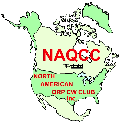
 | NAQCC News |
| Sep 25, 2010 | NAQCC Web Site | Issue #127 | |
|---|---|---|---|
|
In this issue: 1. October Challenge 2. September Sprint Results 3. General Club News 4. Elmer Project 5. Latest Award Winners 6. Member Spotlight 7. News Items and Articles by Our Members |
| 1. OCTOBER CHALLENGE: This is a repeat challenge that drew 13 entries in 2009 and 12 in 2008. Anytime we get into the teens in number of entries indicates a popular challenge, hence the repeat. To sum it up simply and maybe entice you to participate after reading the complete rules, different point values are assigned to different kind of QSO's. A contest QSO is 2 points, a rag chew 5 and so on. Total your points at the end of the month, and submit your entry. Full Challenge info here. 2. SEPTEMBER SPRINT RESULTS: A slight downturn in participation this month. Probably due to a high QRN level that seemed to pervade most of the country and all 3 bands. Still we went over 100 logs for the sixth straight month with 119 (including one late check log) from 178 participants. In the logs were 1,561 QSO's for the cross-checking program. There were participants from 40 states + NS ON SK. Next month will be our big 6th anniversary sprint. Wouldn't it be nice to break all our current records. Perhaps we could even hit 150 or more logs. 20 meters slipped a bit this month, but was still surprisingly good. 40 was its usual good self despite the QRN. Its great to note the big pickup in 80 meters (nearly 200% over August) which should continue through the fall and winter. This paragraph is important not only for our sprints but for the club in general. Our Awards and Certificates manager Rick AA4W asked me to make the following request. Since we now issue over a dozen certificates for each sprint and are sending them via email rather than regular mail to cut costs, if you win one and want to be sure to receive it OK, you must be sure that email from Rick gets through any email filters you or your ISP has. That's also important for our other club emails as well. You should make sure everyone on the 'Contact Us' page gets through any filters if you want to hear from us. Also be sure we have a good email address for you in our records. Let's look at our September stats now including GOLDEN LOGS. Note the new stat of QSO's per participant. The record for that goes back pretty far because then a lot of stations didn't realize how important submitting a log was if they only made a few QSO's. Only those who made "a lot" of QSO's submitted a log.
Congratulations to all including winners and non-winners. Actually everyone who participated and sent in a log is a winner because you have helped show the ham radio world that there are many folks still using and enjoying CW on the ham bands. That's one of our main goals here at the NAQCC. Very special thanks to those who reported their results even though they made only a few QSO's. Your reports are important also. We had a total of 20 stations who didn't submit a log show up 5-13 times in the 119 logs we received and cross-checked. Hopefully they and many others will be back next We welcome these hams who submitted a sprint log for the first time. We hope they will continue to participate and report their results: K4OD K8KSM KD5QAQ K3NLT K8JD W9BOK W1MSW N6VOH N4KZ W5EEA KI8AF K4JQV KI4SP KE7OJV KD8FKD KA3LOC K2HYD(nm) KK1W GOLDEN LOGS. Everyone who submits a log with exactly the correct format as defined in the rules plus has every bit of info (numbers, states, etc.) correct in the log gets a listing in the GOLDEN LOGS section in the results. Many clubs penalize mistakes in logging, some to the point of disqualification if there are too many mistakes. We don't do anything like that other than fixing a score if a mistake changes it. Instead of penalizing errors, we will reward perfection. There also is going to eventually be some sort of prize in conjunction with the GOLDEN LOGS. We haven't decided the details yet. We hope that is an incentive to run a fine-tooth comb through your logs before submitting them. GOLDEN LOG's were submitted by 47 participants this month. To see if you were one of the 47, check the results page. Most GOLDEN LOG's since we started keeping track in March 2010: WB8ENE - 7 (all) KD5MMM - 6 N8XMS - 6 K0HJC - 5 K4JPN - 5 N9KR - 5 Thanks to all GOLDEN LOGgers for making my cross-checking job that much easier. Full sprint info here. 3. GENERAL CLUB NEWS: N1A - W1OH, N1LU, KQ1P N2A - KA2KGP, N2COD N3A - K3WWP, WY3H, KC2EGL, WA3HIC, AF3Z N4A - K3RLL, AJ4SB, AA4W, K2UFT, K0NWT, AD4S, KD4UKW N5A - W5YDM, K5JYD N6A - K6CSL N7A - WY7N N8A - W8RIT N9A - W9BOK, W9DLN N0A - KD0VWith the operation only a couple weeks away now, we need 1 op from each area to commit to operating the sprint. If none from a group can do that, then we need to recruit someone else from that area to operate the sprint. We definitely want to have all 10 calls active in the sprint. I hope some members in W6, W7, W8, and W0 will notice there is only one op signed up for the whole week. We definitely could use more ops from those areas as it's unreal to expect one person to carry the burden for the whole week. Burden is perhaps a poor choice of words as operating a special event call is anything but a burden. It's a really enjoyable experience. To volunteer as an op, just email us at More info upcoming in future newsletters, as well as here. "How can I help?", you may ask. Well, here are some steps that prove very effective. 1. Be sure every time you send a ham-radio related email, you include your NAQCC number in your 'signature', and a link to the club web site if feasible. 2. If you work a station running QRP, mention the club in your QSO and tell them to search 'NAQCC' on the Internet for more details. 3. Anytime you work another contest, try to mention the NAQCC in your soapbox comments. 4. If you have a web site, provide a link to the NAQCC web site. Remember there are logos and a banner available in the main section of our web site if you want to make the link even more impressive. 5. Be sure your QSL card (and eQSL image) has a reference to the NAQCC on it. 6. Bring up the NAQCC at your local club meetings. There are many other ways also, I'm sure, but those are the ones that come off the top of my head as I'm typing this. 5000 is truly remarkable when you think about the limited pool of hams we have to 'fish' from. Those who don't operate CW at all are not interested, as are those who never operate at QRP power levels. That eliminates a lot of fish from the pool right there. 3a. EUROPEAN CHAPTER NEWS:  Items in this section are from EU Chapter President Matt MW3YMY unless otherwise credited. Questions or comments should got to The first ever NAQCC European sprint was held on Monday 13th September. With seven logs submitted, it matched the first ever NAQCC sprint back in 2004, so looks to have a great future just like its American counterpart. Everyone who competed had very positive comments and appeared to thoroughly enjoy the sprint. Stations entered from all across Europe, which is just what the chapter is all about. DL7GEM won with 36 points, MW3YMY came second with 30 points, EA8BVP came third with 24 points, followed by PA7PYR (20 points), OZ8A (16 points), M0KIS (3 points) and DF4WC (2 points). Congratulations to all and certificates will be issued over the next week or so. Full results are available at: http://www.naqcc-eu.org/SepResults.html All entrants entered in the SWA category and most were using a straight key or bug. These are some of the fundamental ideals of the NAQCC and so the sprint looks like it has definitely got off to a good start. All submitted logs were 'golden' logs - the format was perfect with no detectable errors - which makes the job of the sprint organisers very easy indeed. In addition, all logs were submitted within 48 hours of the sprint, most within 12 hours in fact. This is something that we'd really like to keep up, fast logs mean fast results. The next (European) sprint will be held on Wednesday 13th October. These sprints are an excellent opportunity to get on the air and meet other QRP/CW enthusiasts as well as many others. Let's see if we can smash the 100+ log submissions that the American sprints achieve by the end of the year - the more people participate the more fun it is for everyone! The rules will be updated for the next sprint. It is most likely that the multipliers and frequencies will change. These will be posted in the next main NAQCC newsletter. 4. THE NAQCC ELMER PROJECT: 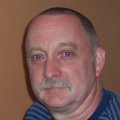  The Elmer project is co-ordinated by Karl N3IJR (L) and Ron K5DUZ. If you are interested in helping out or need help with any CW and/or QRP matters contact: K5DUZ - N3IJR - Elmer's tip: Persistence! Although I've never done it, I imagine when you run a KW and a big beam antenna, you can expect to work everyone you choose to call. Such is not the case running QRP and a simple wire antenna. However it is not impossible, and in fact fairly easy to make QSO's with QRP if you just persist. Many hams call CQ with QRP for a minute or two at most and give up, muttering something about QRP being no good for them. Had they just persisted a little longer, they more than likely would have gotten an answer. Sometimes I get an answer on my very first CQ, even on a band that sounds dead. Other times it may take a half hour or more to get a QSO. A very few times I have gone up to an hour without a QSO. However I didn't give up and persisted till I got my QSO. Often times it turned out to be a great rag chew. Persistence is definitely important in contesting. The best approach to persisting is in calling CQ. You call a brief CQ, tune for a few seconds, and keep following that pattern till you get a QSO, then keep doing it over and over again and you'll wind up with more QSO's than you thought possible because you persisted. Your rate may vary from 1 or even 2 QSO's per minute to a few minutes for each QSO. Just don't give up if you go unanswered for a few minutes. Persist! Many more examples of good operating practices can be found on the Elmer Project page of the web site and on K3WWP's Web Site NAQCC QRS Net Report
Date(UTC) NCS Participants 9/13/10 WY3H 5 - WY3H, K3WWP, K1IEE, N4FI, N1LU/P 9/20/10 WY3H 4 - WY3H, K3WWP, K1IEE, WM4XFrom Tom WY3H - Our net frequency is 7.114.5 and the net begins at 0030Z (8:30 p.m. EDT). The net is quite informal and everyone is invited to check in. If anyone is not familiar with net Q-signals that's OK too (we really don't use them much). The NAQCC would also like members to step up to volunteer as Net Control ops. You don't have to commit to every week. What we are asking members is to try being an NCS just once. We have received several inquiries from our West Coast members regarding a net in that region. We are pleased with the response. May I suggest that when a West Coast net is started, and I hope that is soon, that we have enough NCS volunteers to take turns running the net. If anyone wishes to formulate concrete plans for a weekly net, please contact Tom, WY3H at: We need YOU to make our Elmer project work. If you need help with any ham radio matter or are willing to help others with your expertise, please contact our Elmer directors: K5DUZ - N3IJR - WY3H - Also see Elmer Project on the web site. 5. AWARD WINNERS THE PAST TWO MONTHS: CERTIFICATES: 1000 MPW: 0079 - K1IEE 8/12 0080 - K1IEE 8/12 0081 - K4JC 8/13 0082 - K4JC 8/13 0083 - K3WWP 8/14 0084 - K3RLL 8/27 0085 - K4JC 8/27/10 0086 - K4JC 8/27/10 0087 - K4JC 8/27/10 0088 - K4JC 8/27/10 0089 - K4JC 8/27/10 0090 - AA4W 8/29/10 0091 - WA2OQJ 8/31/10 0092 - KE5YUM 9/2/10 KMPW 100: 0005 - N2JNZ 8/25 30-30: 0008 - K4JC 8/27 WAC: 0015 - W9CC 8/10 ENDORSEMENTS and/or WEB SITE LISTINGS: None Full List of all award winners here. 7. MEMBER SPOTLIGHT:  This section is managed by Paul N8XMS and any questions about it should go to Bob Bartlett VE7CPO #3405 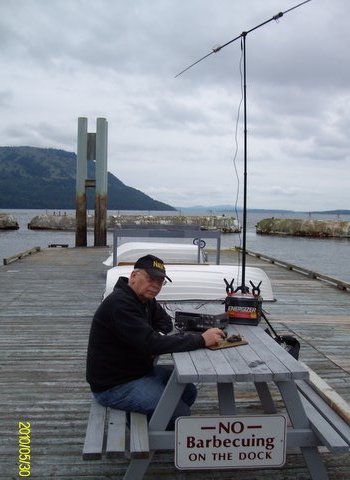 Greetings fellow members of NAQCC, my name is Bob VE7CPO #3405 here with a short editorial for Members Spotlight. Living in a gated community on Vancouver Island prevents me from having outside antennas so one has to look elsewhere to get their signal out. Aside from antennas hidden in my attic our community marina seems to be just the ticket, a 200 foot long dock, picnic table, AC power, and one of natures best grounding systems, the Pacific Ocean. I ventured into QRP after 37 years of Naval service in the communications branch on more destroyers then I care to remember. From high power HF, to satellites, digital, and numerous other modes, just push a button and contact was made, no contest, now with QRP the challenge is back and far more interesting. The rig in the photo is a Kenwood TS-430S, ocean ground, no tuner, car battery powered, coupled to a buddiepole antenna and a heavy brass straight key. Of course power level is QRP unless I work the SKCC gang of which I am also a member. In our gated community of about 1100 folks I also assisted six other residents to acquire their ham tickets. Now we have set up and operate an ARES station for all the residents and linked ourselves with the local government public safety department, a win win for all. This article is short because I recognize people are busy and always have other things to get on with, hopefully connected with radio. If you find yourself on Vancouver Island in the Mill Bay area look for the gated community of Arbutus Ridge, drop by and say hello, I always have some Naval grog on hand to share with friends. Here is listening for you gang. 73 Bob VE7CPO 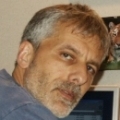 7. NEWS ITEMS AND ARTICLES BY OUR MEMBERS: This section is a forum for you to tell other members what you've been up to on the ham bands or to submit an article dealing with some aspect of CW and QRP operation or equipment. Send your news items and articles to our news editor Paul KD2MX at
7. NEWS ITEMS AND ARTICLES BY OUR MEMBERS: This section is a forum for you to tell other members what you've been up to on the ham bands or to submit an article dealing with some aspect of CW and QRP operation or equipment. Send your news items and articles to our news editor Paul KD2MX at DISCLAIMER: Any views expressed in this section are those of the member submitting them, and may or may not be those of the NAQCC or its officers. I'm still having fun operating the Begali key and paddle so kindly given to me by the NAQCC through your donations. I feel I need to say thanks again to all the donors and especially to Tom WY3H who came up with the whole idea. I've also done some work on the Tuthill 80 xcvr given to my by Don K3RLL. It had a drift problem which I believe is now solved by adding more NP0 capacitance across the non-NP0 trimmer capacitor. I've made 3 QSO's with it so far, and am still getting used to the difference in zero-beating stations from what I've been used to over the years with my Kenwood and homebrew rigs. Field Day is one of those special contests for me because it is the one time a year to try out a new idea for an antenna that won't fit in my city lot. Over the years I've tried lots of antennas with varying success. I have opted mostly for dipoles and loops because of their simplicity. The last few Field Days I have used QRP power levels with good luck, but this year I wanted something that would give our signal some OMPAH. After much thought, I decided to give a "Bruce Array" a try. I chose 20m for the test band because the size of the array makes it quite large on 40m or 80m. Even on 20m it gets a bit large. I decided to build a 5-element version and was able to scrounge all of the wire for the project from my junk box. The only thing I had to purchase was a long thick halyard to hold the weight of this monster up. One Saturday afternoon I got out the dykes and the measuring tape, and started in on it. The antenna went together fairly smoothly. I had to use my neighbor's yard and about half of the street, but in a few hours I had a beautiful "curtain" to hang. I didn't want to bring an antenna out to Field Day that had not been tested so I called up Bob K8RDN, to see if he wanted to assist. We agreed to meet at a local school where we got out the bow-and-arrow for some Robin Hood action. My very first shot to put a line up in the trees was a great one but it went downhill from there. Trying to get a line up in the second tree proved to be the problem. The next shot was awful. It went high, the arrow got stuck, the fishing line snapped and my arrow stayed up in the tree. On to Plan "B". I got out my backup arrow and tried to shoot a heavier line. I got it up there ok but the line was too heavy for the arrow weight to pull down to the ground. After many attempts, and a few well chosen words, we opted for Plan "C". With darkness approaching, it had to be now or never. I retrieved the reel from my spare fishing pole and attached the arrow. After a couple of spoiled shots, I finally hit "pay dirt". Now we had two support lines in place and were ready to pull up the Bruce Array. It was then that we found that the space between the two trees, which I had carefully paced off, was not large enough to support the entire array. It was drooping in the middle but we decided it was better than nothing and it was time to feed the array some RF. I quickly hooked up the open wire feedline and on power-up we heard some signals on 20m, but nothing great. Our attempt to tune up revealed that I had an "open" piece of coax. Of course, I had several good cables in my hand just before leaving the house, but now none could be found when needed. We finally rigged up one of those twist-on style BNC connectors, plugged it in, and my speaker about jumped out off the radio! That was more like it. The antenna was broadside to the east-west and now the W6's were coming in "loud and clear". We tried calling a few but had no takers. We then called a few CQ's but again, no takers. Finally, I called a K5 in Texas who came back to us with a 569. Both Bob and I were happy that we got a QSO in before dark. It was now starting to rain and the mosquitoes had "zeroed in" on us. I wanted some more time to experiment but it would have to wait for another time. Tear down was surprisingly easy. The big test would have to wait until Field Day. The night before Field Day saw a flurry of activity. There were new ntennas to try and we anticipated some FB results. We had the 5-element Bruce Array" for 20m plus a full-size 2-element cubical quad for 40m. Our antenna arsenal was loaded for action. We pulled up the 40m driven element Friday night and it provided instant joy when hooked it up to my QRP rig. But I still had a question in my mind as to whether I had chosen the right antenna with the Bruce array since our test the week before had resulted in only one QSO. The big "curtain" was pulled up on Saturday morning. As soon as the ladder line was attached to the Johnson Match Box, we hit pay dirt. Several QSOs off the side to New England confirmed that the array did have side lobes. The next QSO confirmed what we really wanted to know. Our call to FM5LD in Martinique, with just a handful of watts, resulted in a 599 and showed that indeed we had a winner. Then our old pal Murphy showed up again. We started Field Day on 40m with our QRP rig to earn the solar power bonus and in ten minutes, we had our Q's. But as soon as we went to the big rig we had power troubles. The ground fault breaker on the AC kept tripping. OUCH! We went back to the QRP rig and continued to log contacts. Soon the power problem was resolved and we went to 20m to see how well the big array would play. The effort in building it was immediately rewarded with "LOUD" signals. The first couple of hours, we worked everything we heard. Rates were very good, and the "wire curtain" was a great performer. We would nearly always beat the other guy if two stations were calling at the same time. The side lobes were very beneficial and the main lobe were terrific! This antenna will definitely be in our line up for future Field Days. When evening fell, we switched to 40m with the full-size quad aimed at New England. We were "booming in" East and West and the log was expanding at a nice rate. Sometime during the wee hours of the morning, the bands just dropped out and it was slow going for several hours. Then we loaded up the Bruce Array on 40m and started putting them in the log again. It seemed there was nothing that this antenna could not do! We even loaded it up on 15m later in the day, and it did quite well there too. With good aerials, good propagation and good luck, we all had a great time finishing with a total score of 474 QSOs, almost double last year. 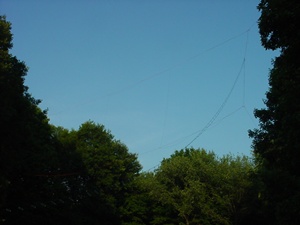 The full size 20 Meter Bruce Array at Field Day More Thoughts on the Bruce Array I was really impressed with the performance of the array. However, never having had one to play with before, I wanted to experiment more. The problem was, you need a 120-foot span and two 50-foot tall supports so I couldn't play with it at home as I wanted. My solution was to scale it down to another band with more manageable proportions. I chose to build one for the 70cm band where I could make a 5-element version in about a yard of space. Here is where the fun comes in. Since I work in the Electrical Engineering Dept. at Michigan State University, I have access to a variety of nice test equipment including network analyzers and an anechoic chamber. I wanted to see if my scaled down version of the array had radiation patterns similar to the full size version. The one I used for Field Day was end-fed rather than in the middle as is recommended in the textbooks. So I built two versions. The first was center-fed with parallel line and a 4-to-1 balun where the second was end-fed. Both were made from ordinary #22 insulated wire and were stapled to poster board for mechanical support. 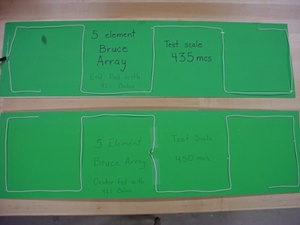
The two test models scaled to 70cm band I hooked each up to the network analyzer to see what the matching and Smith Chart characteristics were. Both antennas had resonance in several different spots in the spectrum with a very wide bandwidth and low SWR across the band. Then it was into the chamber to see what the radiation pattern looked like. This was very interesting indeed and it confirmed some of my suspicions from Field Day. It had seemed that we not only had main lobes but side lobes too. The chamber proved this to be correct, but not exactly as I had thought it would look. Imagine north being straight up and the antenna running from east to west. The pattern looked like a somewhat flattened "X". This confirmed the lobe patterns of our Field Day contacts. It was very cool to have real information to back up my theory. 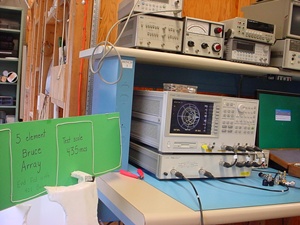  Here are pictures of the test setup. 
That is me in the photo. I was a signalman on a destroyer during the Vietnam conflict so I can identify with these small ships. I have enjoyed making radio contacts with some of these history makers over the years. My log book lists an old Coast Guard cutter up on the Great Lakes, a battleship in North Carolina, an old destroyer in Baton Rouge, and a submarine near Pittsburgh, Pennsylvania. As I left the bridge on the LST-325 (these ships had no names), I asked one of the crew members if the radio room was still functional. To my amazement, he stated that there were several hams aboard who kept it alive and, better yet, were currently on the air. I thought, being a ham, does it get any better than this? Well yes, it does. The crew member escorted me back onto the bridge and led me into the radio room, which was behind the helm and engine order telegraphs. I was in radio heaven now. I met Bob, N9AXW, here and we talked for a few minutes about the ship's 600-watt transmitter and antennas while dits and dots filled the background. He asked if I would like to operate the radio. Of course I was ecstatic. So being a QRP operator and thinking 40 meters, I sent out the ship's call of WW2LST on 7040 a few times but got no response. I then tried the 40-meter FISTS frequency of 7058 but again, no luck. Bob suggested I try 20-meters and he retuned to 14.027 for me as I didn't know the intricacies of the tuner. I sent the call out again and this time, the K6AA club station answered from San Pedro, California. It was a weak signal, with heavy QSB, but we managed to exchange the basic information. John stated they were a "club station" near Los Angeles California, and on the coast. When I asked earlier in this post "Does it get any better than this?", well yes it actually does. My wife and I had been in Los Angeles a few years ago awaiting a long flight and we stayed in a hotel near Huntington Beach. Several times we walked down an old rail trail to the shore to watch the volleyball players. As we had approached the shore, I had noticed a large white building with dozens of wire antennas and a large beam on the roof. I specifically mentioned to her that I'd love to get my hands on that transmitter and those antennas someday. I assumed that it was a Coast Guard Station. It turns out that this was K6AA, the station I worked from WW2LST. What a wonderful coincidence. I will remember this contact for years to come. 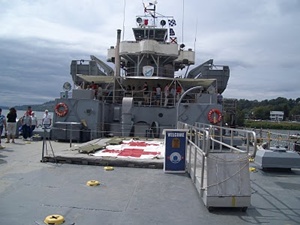
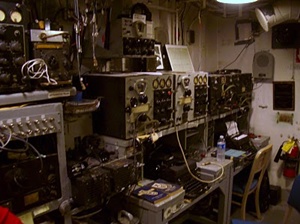 LST325 & WW2LST Radio Room (Note from K3WWP: This is an excellent undertaking by Keith, and I deeply appreciate it. I believe I will incorporate it into our General Sprint Rules page when time permits. I have added a couple notes here and there to clarify a couple things that I observe when cross-checking logs) I recently installed GenLog but found it a little intimidating. I discovered some issues in understanding how to create a 'Golden Log' and it took me a while to make GenLog generate a log file appropriate for the NAQCC autologger. Here I suggest what a new user needs to know to feel more comfortable using GenLog for our Sprint. Once you see how simple Genlog is, and gain a little experience, I think you will look forward to using it. Getting Started - GenLog is available as a free download. It is unique among the many logging programs in that it provides special handling of our NAQCC Sprint contest format. You should download the latest version of the base application and its latest update. The download kits can be found at: http://www.qsl.net/w3km/gen_log.htm. Installation is straight forward and I installed it in the default directory of C:\genlog32\. NAQCC-specific Membership File - GenLog does some really nice things automatically. For example, when you enter a callsign it will look in the NAQCC.DAT file to see if that call belongs to a NAQCC member. If a corresponding record is found, GenLog automatically fills in the State, Member#, Multiplier and Points fields, saving you quite a bit of your time. If you have already worked the same multiplier prior to the entry, GenLog will enter a dash in the multiplier column. Very nice! This file is included in the standard installation but you should always download the latest version prior to the Sprint. You can find the latest version at: http://www.qsl.net/w3km/gen_data.zip. Extract the NAQCC.DAT file and place it in the directory that contains GenLog. (Note: That is NOT always necessarily the latest naqcc.dat file. To be sure of getting the very latest which I personally update the morning before our sprint, see the General Sprint Rules page for instructions on downloading naqcc.zip from the NAQCC web site. Check the included readme.txt file to be sure you have the updated file for the upcoming evening sprint.) Working with GenLog - You cannot break anything when playing with GenLog. You might make plenty of mistakes at first and that is ok. This is actually the best way to become comfortable with GenLog. Just make up fake contest entries and see what GenLog does with the data. Use some real member call signs so you can see how GenLog automatically updates fields. When you feel comfortable with your testing, then you will be ready to confidently use GenLog in a live Sprint. That is the ultimate goal. Starting GenLog - When you start GenLog for the first time you must enter certain information in the initial screen. Complete the callsign, Local Time UTC Offset, Name, Address, etc.. Make sure you indicate the time difference between your local time and UTC time. Not all of this information is required for the NAQCC Sprint but fill in what you can and then move on to the next screen. You will see this same screen each time you start GenLog so you can change any values at a later time. Select the Contest - You must tell GenLog the name of the contest. The screen input format and output file format is determined by selecting NAQCC Sprint as the contest. Here is how you do that: Click on 'File', then 'New contest' and finally the 'QRP' button. This will limit the contest names to just those that are considered QRP contests. Scroll down to 'NAQCC Sprint' and select that contest. Then click 'Continue'. You will see a subtle difference in the screen format. Some of the fields will be customized to our Sprint. Name Your File - You need to give GenLog a name for the files it will create during the session. Click on 'File' and then 'New Filename'. Enter in a unique file name such as NAQCC_Sprint_20100824 (meaning the NAQCC Sprint that took place on Aug 24, 2010). You will see the filename listed in the box to the left of the digital time on the screen. You can recall the file at a later time by double clicking the filename. (Note: In case you missed it in the GenLog instructions, DO NOT name this file with your call letters) Entering Contacts During or After the Contest - You have the option of entering contacts in real time or after a contest. I enter my contacts AFTER the contest so I click on the 'radio button' called 'AFTER CONTEST'. This is a good way to become familiar with the program. If you are entering 'After Contest' then you must enter the UTC Date and Time. This is entered automatically for you if logging with the button set to REAL TIME. Real time entry is the most efficient. (Note: Be sure your computer clock is correctly set if you use real time. In cross-checking I often note many QSO's are several minutes different from the matching QSO.) Logging Your Contacts - The first thing to check is that the correct BAND has been selected. Click on the drop down button to the right of the band indicator box and choose the correct band. Set the MODE box to 'CW'. If you are not logging in real time, then enter the time of the contact in the TIME box. Use all four digits. For midnight UTC you would enter 0000. For 25 minutes after midnight you would enter 0025. Enter the call sign of the station you worked in the CALL field. If the call is found in the NAQCC.dat file, then the STATE abbreviation and NAQCC# will display, the MULTIPLIER will be set and the POINTS value will change to the value 2. This is a HUGE time saver. (Note from K3WWP: Remember you must have the very latest naqcc.dat file from the NAQCC web site or the newest members will show up as non-members.) You can leave the information in the REPORT field at the default values as it is not required. But the field cannot be blank. The default is typically '599'. However it is best practice to include the correct data if you can. If not automatically populated, you must enter the state, province or country sent to you in the St/Pr/DX field. Use the standard abbreviations. Be sure that the data you receive is the same as that automatically entered since a station could be operating portable away from the home QTH. In the #/Pwr field, enter either the NAQCC Member# or the power value sent by the non-member contact. The member number is automatically entered if the call is found in the NAQCC.dat file. If you need to enter a 'Pwr' value be sure to include the 'W' for WATTS (as in 5W). Enter 2 for a member and 1 for a non-member in the POINTS box. This will have been updated automatically if the call was found in the membership data file. Use the ENTER key rather than the mouse to move between fields as it speeds up the entry process. When you get to the large gray 'SaveData to Log' button, press the ENTER key yet again. This will place the contact into the working log file. If it does NOT go into the log then there is a field that has probably been left with unacceptable values (maybe a field is BLANK). (Note from K3WWP: The space bar works exactly the same as the enter key and for me at least is easier to use. DO NOT use TAB as that causes strange results.) You will see that a new logged contact line is added to the bottom of the screen. The cursor will automatically jump back to the TIME box or CALL box. You are now ready to start a new contact entry. The BAND is ASSUMED to be stay the same so be sure to modify it when changing bands. (Note from K3WWP: To change bands simply type 80, 40, or 20 in the CALL box and press enter or space bar.) Making Corrections - You can make changes to the working log while running GenLog. There is a yellow box located under the displayed digital TIME that will allow you to change field data in the 'working log' entries. Editing through this interface will correctly adjust MULTIPLIERS but make sure any changes you make are COMPLETE and CORRECT as far as the remaining fields are concerned. Be sure to press ENTER after EACH field change. Creating the Log File - After you have entered your last contact, you are ready to create the NAQCC Sprint .log file. Look at the top of the screen for 'Log' and click on that. Now click on 'Write ASCII Log [YOURCALL.log]' You see that the name of the log is the same as the callsign that you entered on the first screen (your call). The log will be displayed in Notepad and you can make any changes needed. If you make any MANUAL corrections to the .log file then you will need to make sure the multipliers are correct after your changes. Scan down the right most column and make sure the QSO point value is correct for your contact, two points for a member and one for a non-member. Scan down the BAND column and adjust if necessary. If you modify a line that requires the MULTIPLIER to be corrected then it might affect ALL OTHER multiplier values starting from that point and going down. That could be a pain. It is worth it to make sure you enter the data into GenLog correctly the first time so that you do not have to fix anything that pertains to adjusting the multipliers in this file! Or make the corrections as described above using the integral edit feature. Submit Your Log - The lines pertaining to contacts are exactly the way that NAQCC wants your information. Highlight all of the lines EXCEPT the first line containing labels, right click on the mouse, choose COPY, go to the area for entering the log information in the NAQCC on-line autologger, and PASTE the log data into that data box. Miscellaneous Issues - There are a couple of check boxes of interest on the second screen. The first checkbox is '599'. If this is checked then the value 599 is automatically placed in the contact field labeled REPORT. If the checkbox does NOT have a check in it then you will need to enter a signal report manually. The second checkbox is 'END'. If this checkbox is checked then the very last line in the 'working log' will always remain visible. If the checkbox does NOT have a check in it then the first entries in the 'working log' are always visible. Quest for the Golden Log - Following the above steps should bring you up to speed very quickly on using GenLog and producing the specially formatted NAQCC Sprint log. Hopefully it will also help you attain the highly desirable 'Golden Log' listing and minimize the workload for the NAQCC Sprint log checker. (AMEN! - K3WWP) | ||||||||||||||||||||||||||||||||||||||||||||||||||||||||||||||||||||||||||||||||||||||||||
Club email address - The publication of our next newsletter will be announced via email to all members for whom we have a valid email address unless you specifically have unsubscribed from the email. Past on-line newsletters beginning with issue #042 are now archived on the site. So if you missed seeing any past issues, you can check them out in the archives. Unless otherwise credited, all items are written by K3WWP. If you came directly to this newsletter, we invite you now to browse the NAQCC Web Site. | ||||||||||||||||||||||||||||||||||||||||||||||||||||||||||||||||||||||||||||||||||||||||||